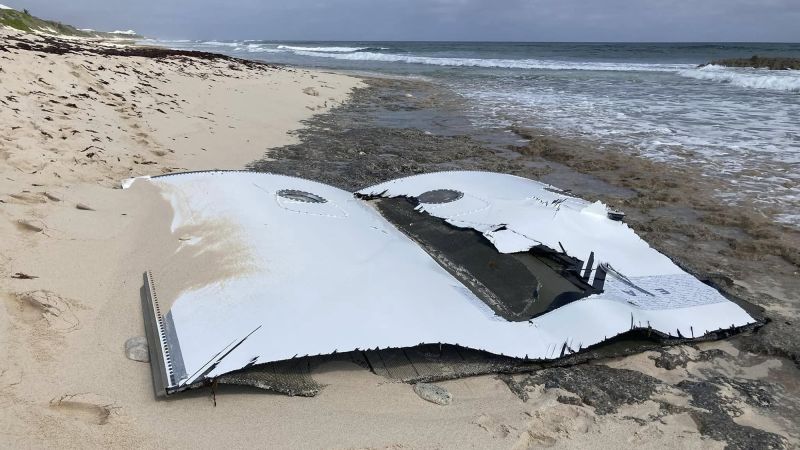In recent developments within space exploration, the phenomenon of space debris has garnered significant attention. This week saw a striking episode when a large piece of a Blue Origin rocket’s nose cone was washed ashore on a Bahamian island renowned for its tourist attractions. This incident coincided with a series of flaming debris from a SpaceX launch vehicle that illuminated the skies over Germany, the remnants apparently landing on private property in Poland. Such episodes highlight the multifaceted nature of space travel and its unforeseen consequences on Earth.
These events, interestingly, are separate from the notorious incident in January, where a SpaceX Starship rocket exploded during a test flight. Debris from that event rained down close to the Turks and Caicos, leading local residents to engage in extensive cleanup efforts on their beaches, roadways, and bays. These recurrent mishaps have sparked discussions about the safety protocols surrounding the testing of unreliable launch vehicles that traverse areas populated with civilians. The juxtaposition of this week’s space debris events with previous mishaps emerges as a significant narrative, illustrating how the successful launches of rockets can inadvertently affect earthly environments.
A crucial factor in these incidents is the increasing frequency of rocket launches, which inherently elevates the probability of space junk descending into populated regions. According to the European Space Agency, debris falls to Earth on a regular basis; however, most objects disintegrate upon re-entry due to the intense friction generated while plummeting through the atmosphere. The agency indicated that satellites and medium-sized rocket components re-enter the atmosphere nearly daily, while smaller tracked debris is even more frequently recorded.
The SpaceX debris that illuminated the skies over Europe represents an unusual case. The remnants were traced back to the second stage of a Falcon 9 rocket which completed its primary mission of delivering satellites for SpaceX’s Starlink network. However, the upper stage failed to execute its typical controlled splashdown in the ocean, entering uncontrolled descent instead. Astrophysicist Jonathan McDowell from the Harvard-Smithsonian Center for Astrophysics revealed that this uncontrolled re-entry likely brought the Falcon 9 debris into the European atmosphere and led to its crash landing.
The dramatic sights of the disintegrating rocket parts were captured by individuals on the ground, including a German train driver named Ludi, who noted the unusual spectacle flying above. The European Space Agency corroborated these sightings, as did the Polish Space Agency, which reflected on the trajectory of the rocket debris and its potential impact on Polish territory. Social media was abuzz with images of what seemed to be an intact fuel tank that potentially landed near Poznań, Poland, coupled with local news accounts discussing the phenomenon.
Adding to the excitement, the Polish hardware company Elektro-Hurt posted images of the rocket part on its premises, humorously referring to it as an “extraordinary delivery.” While the definitive reasons for the Falcon 9’s upper stage failing to maintain the controlled descent remain ambiguous, investigators from the Federal Aviation Administration (FAA) are looking into the matter, adhering to regulations that require SpaceX to report anomalies within 90 days.
The importance of addressing the risk linked to space debris is underscored by experts in the field. Marlon Sorge, the executive director of the Center for Orbital and Reentry Debris Studies, highlighted the potential dangers posed to individuals on the ground, especially if toxic substances are involved. Despite the risks, it is important to emphasize that incidents of injury or damage resulting from space debris remain exceedingly rare.
The case of the Blue Origin debris in the Bahamas is less alarming than the other incidents, as it was expected to be disposed of in the ocean after the rocket’s maiden flight. Despite these events raising valid concerns regarding safety and environmental impacts, experts reiterate that the annual risk of a human being harmed by falling space debris is less than one in 100 billion. In fact, an individual has a significantly higher probability of being struck by lightning.
Nonetheless, with the booming launch schedule of companies like SpaceX and Blue Origin, these occurrences are likely to continue, reopening discussions on the regulations governing space launches and the ongoing responsibility of space agencies to mitigate risks associated with space debris. Proper recovery protocols are essential, and both Blue Origin and NASA have established ways for the public to report US-originating space debris. As space exploration progresses, infrastructure for handling and addressing space debris hazards will need to evolve correspondingly.



